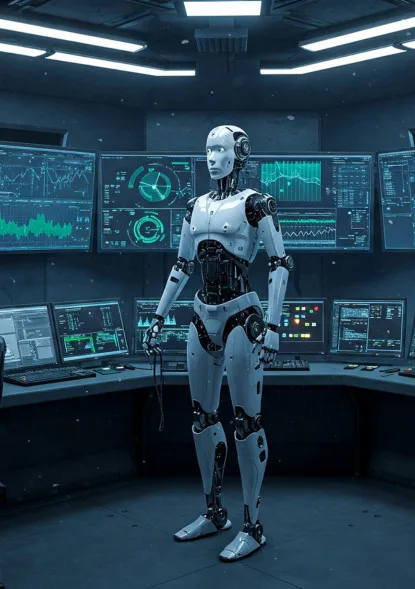In today’s world, data is more abundant than ever. It drives our decisions, forms the foundation of our innovations, and reflects our performance. But what’s the point of gathering vast amounts of data if you can’t understand it?
Without clear and insightful interpretation, data remains silent.
That’s where data visualization, commonly known as dataviz, comes in. It transforms raw numbers into clear, actionable information, which is essential for managing critical systems, such as those found in control rooms.
What is Data Visualization?
Imagine thousands of numbers lined up on a screen. Without a visual aid, it’s impossible to make sense of them, identify trends, spot anomalies, or see connections. This is where data visualization truly comes into its own.
It transforms complex information into simple charts, interactive maps, or real-time operational dashboards.
Data visualization tools enable you to:
- Quickly understand information: Our brains prefer images. We process visual information far faster than text or numbers. A well-designed chart can tell a complete story in an instant, allowing you to grasp complex situations quickly and respond faster.
- Identify trends and issues: Charts make it easy to spot changes, unexpected spikes, or drops. This capability is crucial for anticipating failures, improving processes, or detecting weaknesses in monitored systems.
- Make better decisions: When data is accessible and clear, managers and operators can rapidly assess the situation, evaluate possible outcomes, and make faster, more informed decisions. In a control room where every second counts, this is vital.
- Communicate effectively: Dashboards can be understood by everyone, enabling data sharing across technical teams, management, or clients, making information accessible to all stakeholders.
- Optimize supervision: Whether it’s IT systems, industrial infrastructure, or connected sensors, data visualization tools provide a valuable overview. They are indispensable for real-time supervision and for addressing issues before they escalate.
Data Visualization: A key enabler for AI
Data visualization plays a crucial role in artificial intelligence projects, especially in supervisory environments. AI models generate vast amounts of data that would be meaningless without appropriate visualization tools.
Visualization allows you to leverage AI capabilities by connecting them to real-world operational needs.
It makes AI outputs understandable and actionable, essential for effective management and real-time decision-making.
Its usefulness can be broken down into several key areas:
- Presenting results: Transform AI model outputs into clear, comprehensible information for management and operational teams.
- Understanding predictions: Seeing how a model reaches its conclusions is vital for trust and validation, especially when AI is deployed in high-stakes, critical applications.
- Facilitating incident management: In a control room, precise visual indicators help operators quickly identify alerts, understand the context, and initiate appropriate procedures.
- Monitoring AI performance: Track key metrics like accuracy, recall, error rates, and other vital indicators in real time to ensure the reliability of autonomous systems.
Powerful tools for a critical challenge
There is a wide range of data visualization tools on the market, varying greatly in price, features, flexibility, and robustness. Power BI (Microsoft) and Tableau (Salesforce), widely used in the corporate world, allow users to quickly achieve satisfactory results for predefined use cases. Conversely, Plotly (open-source) is a highly technical tool offering vast possibilities but with a steeper learning curve.
Grafana, as a flexible and robust open-source platform, excels at creating operational dashboards and real-time visualization. It is an ideal tool that perfectly meets the needs of control rooms and supervision environments.
Why Grafana is an excellent choice for supervision
- Open-source and Modular:
As an open-source platform, Grafana is continuously improved and enriched with new features and integrations. Its ability to connect to a wide variety of data sources (Prometheus, InfluxDB, PostgreSQL, MySQL, etc.) simplifies the integration of information from highly diverse systems.
- Extensive Connectivity:
Grafana natively supports a broad range of data sources. For those not yet supported, community-created plugins are always available. This versatility is a major advantage for centralizing data from various sources—whether industrial sensors, ERP systems, CRM solutions, or other business tools.
- Intuitive and Customizable Dashboards:
Grafana’s strength lies in its ability to create highly customizable operational dashboards. It enables the design of real-time monitoring charts, gauges, heatmaps, tables, and many other visualization types—all through a user-friendly interface. This allows for tailored screens adapted to each supervision or analysis need, providing operators with essential overviews.
- Alerts and Notifications:
Beyond visualization, Grafana includes an alerting system that notifies teams (via email, Slack, Teams, etc.) when thresholds are crossed or anomalies detected. This feature is critical for proactive supervision and rapid response in time-sensitive situations.
- Flexible Integration:
Whether displaying AI project results or analyzing simple data, Grafana adapts to a variety of scenarios. It can be deployed on-premises or in the cloud, offering great flexibility to integrate with existing infrastructures.
- Community and Documentation:
Grafana’s large user community and comprehensive documentation are valuable resources for developing, deploying, and maintaining data visualization solutions.
Concrete examples of Grafana in action
- Status Monitoring of Critical Surveillance Systems:
Cameras, security sensors, with alerts triggered in case of issues.
- Key IT and Network Performance Indicators Under Supervision:
Bandwidth usage, throughput, average latency, packet loss rates, etc.
- Data from Connected Sensors (IoT):
Used to monitor industrial equipment in real time (temperature, vibrations, pressure, energy consumption, etc.), detect early warning signs of failure, or track smart building infrastructures (occupancy levels, air quality, humidity, lighting, etc.).
- Geospatial Maps for Supervising Distributed Infrastructures:
Allowing quick localization of events or failures.
Conclusion
By integrating a data visualization tool like Grafana into your control room, Motilde enables optimized utilization of all your data. Coupling such a tool with expertise in artificial intelligence and event management significantly enhances the performance metrics of your operations centers.
The AI in Control Rooms Guide
Discover how AI can transform your operations and optimize the supervision of your processes.
